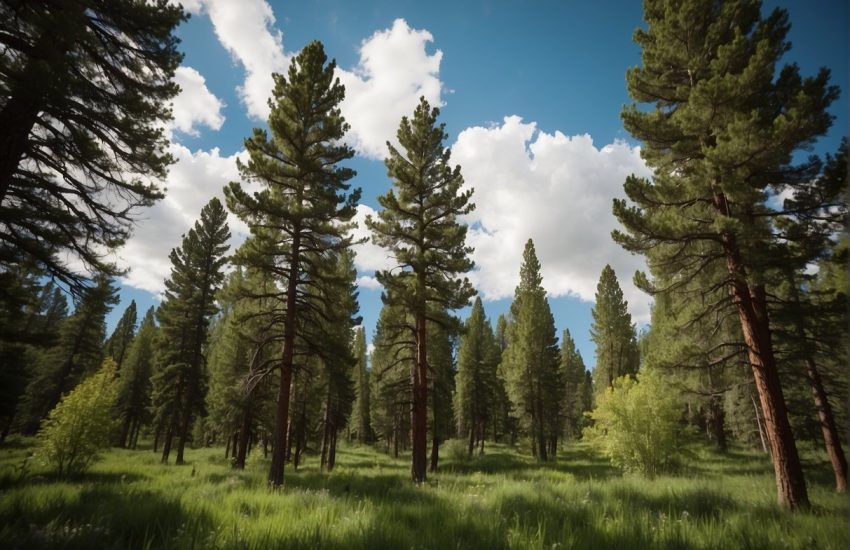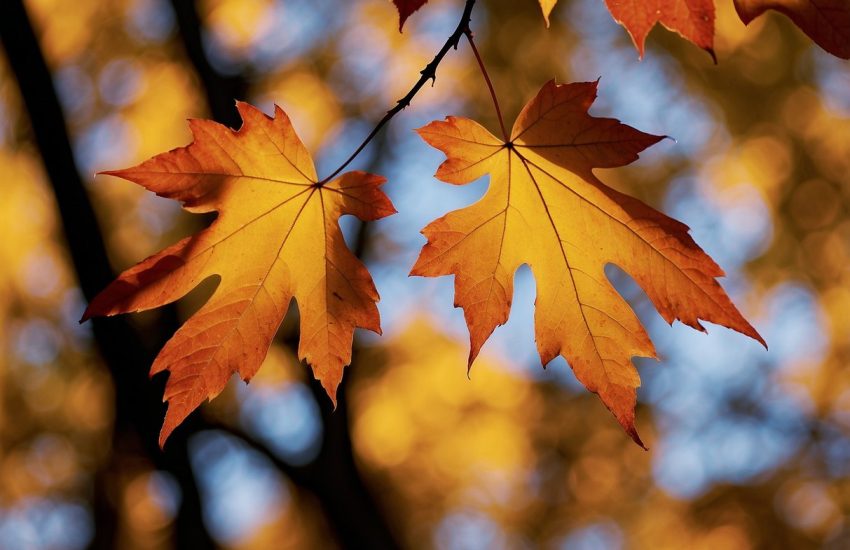15 Ornamental Trees to Grow in Colorado
There’s no shortage of ornamental trees that grow well in Colorado. Below, you’ll find 15 showy specimens that do well in the Front Range, Western Slope, and beyond. Check out the unique foliage, flowers, and fruits that these trees yield. Combine them to create a truly spectacular privacy screen or partition. These phenomenal plants bring color, fragrance, and texture to your yard. Many of them are excellent hosts for insects, birds, and other wildlife.
Flowering Crabapple (Malus)
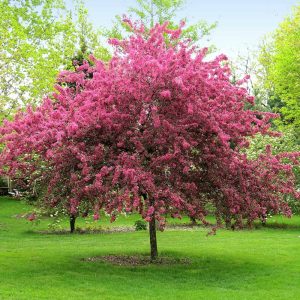
Crabapple trees are some of the most common ornamental trees found in Colorado. Nothing beats the flowering crabapple of Colorado’s Front Range. Colorado’s streets are aglow with pinkish-purple flowers in spring. Crabapple’s flowering season runs from April to May. Most trees stay in bloom for just one to two weeks. However, there are enough alternating crabapple varieties to ensure that the blossoms are around all spring.
The tree’s fragrant flowers preceded its small fruits. Crabapples are a lot like real apples. However, they are no bigger than 2 inches in diameter and not as fleshy as their more edible cousins. Some crabapple varieties offer up excellent fall foliage. Their leaves may turn yellow, orange, or red as Colorado’s summers wind down. Crabapple trees also tend to have dense, widespread crowns. Their trunks are crooked and spindly with mottled or exfoliating bark.
Robinson, royal raindrops, Sargent, and radiant are just a few crabapple varieties that do well in the Centennial State. Check out Colorado State University’s Extension to find a complete list of flowering crabapple trees that are native to Colorado.
Rocky Mountain Juniper (Juniperus scopulorum)
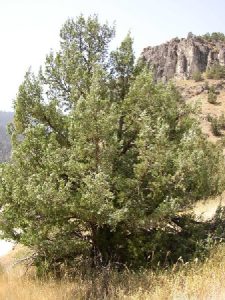
Rocky Mountain Juniper, or mountain red cedar, is an evergreen tree that offers year-round beauty to Colorado landscapes. The juniper’s silvery-blue foliage is needle-like and fragrant. It boasts blueberry-like fruits. This particular variety acquires a whitish hue when it is young. Its bark tends to appear reddish-brown and mottled.
These showy trees can grow 30 to 40 feet by the time they reach maturity. A full-grown Rocky Mountain juniper tree’s crown may be anywhere from 3 to 15 feet in diameter.
According to the Colorado State University Extension, other juniper varieties that do well in Colorado are alpine carpet, tabletop blue, and blueberry delight. Rocky Mountain Juniper is often used for ornamental purposes. However, its presence is also appreciated by native insects and animals. It’s a host plant to the olive butterfly. Its seeds are beloved by all sorts of birds and small mammals. Many animals seek cover or build nests in its foliage.
Tatarian Maple (Acer tataricum)
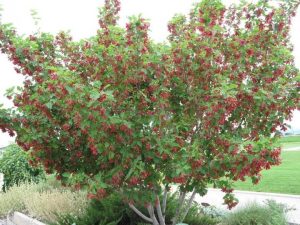
Tatarian maple is a hardy tree that offers up spectacular color in autumn. The deciduous tree’s orange-red canopy serves as a celebratory reminder of seasonal change. In spring, birds and other small animals gather to collect the tree’s winged seeds.
This is a drought- and disease-tolerant tree that does well in Colorado’s dry, alkaline soil. While its greenish-white flowers are that impressive, its red-tipped seeds are rather spectacular. Moreover, its dense foliage offers up much-appreciated shade and protection.
Golden Rain Tree (Koelreuteria paniculata
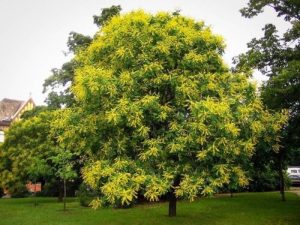
The golden rain tree is a medium-sized deciduous tree that grows well in Colorado’s Front Range and at altitudes up to 6,000 feet. It yields dark green leaves, pale yellow flowers, and reddish-brown seed pods.
The golden rain tree is native to Asia. However, it’s also well-adapted to the Front Range’s alkaline soil and scorching sun. It can tolerate heavy pollution and less-than-desirable soil. This dazzling plant produces foot-long pannicles of yellow flowers in summer. The star-shaped blooms fall one by one. The shedding blossoms serve as the inspiration for the tree’s name. The golden rain tree’s fruits are equally distinctive. The paper-like brown pods resemble Chinese lanterns. Each one has three seed-filled capsules. They are often trimmed from the tree and added to cut flower arrangements.
This incredible tree is perfect for Colorado yards and landscapes. It unpacks all sorts of surprises and can even be added to bouquets. It’s one of the few trees that can handle Colorado’s extreme weather and unique growing conditions. Its eye-catching beauty lasts all year round.
Japanese Tree Lilac (Syringa reticulata)
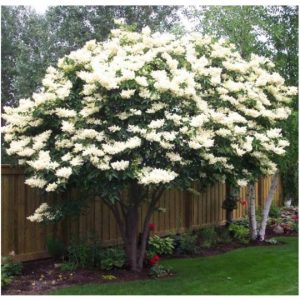
The Japanese tree lilac is a close relative of the lilac shrub, one of Colorado’s most popular landscaping plants. It boasts green foliage, white blossoms, and reddish-brown bark. Its fragrant flowers attract a wide variety of insects and songbirds. The tiny blossoms grow from upright panicles. The cloud-like clusters bloom in early summer. The showy display lasts for anywhere from one to two weeks.
Japanese tree lilac can handle extreme temperatures, high elevations, and alkaline soil. It’s small in size and does not spread far. Mature trees are usually around 30 feet tall and 20 feet wide. It is preferred for its year-round showiness and compact size. Its unmatched aesthetic value makes it a top choice for most Colorado gardeners.
Canada Red Chokecherry (Prunus virginiana ‘Canada Red’)

Canadian red chokecherry is an ornamental tree that fairs well in Colorado’s extreme climate. This plant boasts bright green leaves, a rounded crown, showy flowers, and small fruits. It can grow to be anywhere from 25 to 30 feet tall and 15 to 20 feet wide.
The Canda red chokecherry’s fragrant blooms are creamy and rounded. They grow from raceme-like stalks that are located at the end of the tree’s branches. The showy flowers precede the plant’s reddish-purple berries. The fruits’ flesh is edible. However, their seeds are not. As such, they are best left for the birds and other small critters.
Ornamental Plum (Prunus triloba)
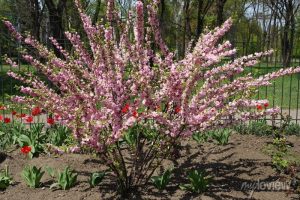
The ornamental plum is a flowering tree that originates from Europe and Eastern Asia. It boasts an upright trunk, a vase-shaped crown, mottled bark, and white flowers. The five-petaled blossoms bloom in spring. They appear at the same time as the tree’s purple foliage.
These trees are early bloomers. They’re known for their flowers rather than their fruits. However, they have been known to produce edible fruit on occasion. The fruits are usually no bigger than 1 inch in diameter.
Purple Smoke Tree (Cotinus coggygriala)
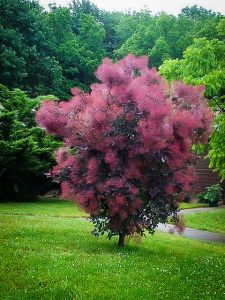
The purple smoke tree is another unique deciduous tree that generates year-round interest. Its canopy is made up of a dense, rounded cluster of purple leaves and sprouts of soft, purple flowers. Its crown can grow to be anywhere from 10 to 12 feet wide. This aesthetically pleasing tree does not usually grow to be taller than 15 feet. Its crown may be rounded or oblong.
Northern Catalpa (Catalpa speciosa)
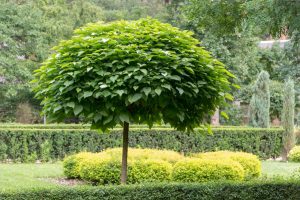
Northern catalpa is another attention-grabbing tree that thrives in Colorado’s dry soils. The catalpa yields large, heart-shaped leaves and long, bean-like seed pods. Its whitish blooms give us something to look forward to in springtime. Its lengthy green and brown seed pods are equally eye-catching. Its large crown offers up plenty of shade.
Kentucky Coffee Tree (Gymnocladus dioicus)
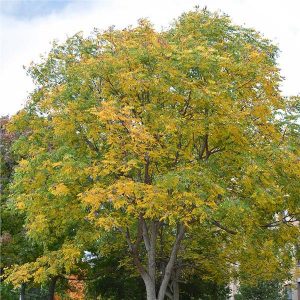
The Kentucky coffee tree is a popular shade tree with several ornamental qualities. Its large, bipinnate leaves are typically 3 feet long and 2 feet wide. Individual leaflets are usually no bigger than 2 inches in length. This phenomenal plant can produce hundreds of bean-like seed pods. The lengthy growths turn brown in summer but remain on the tree well into the winter. The plant also produces clusters of greenish-white blossoms. These appear during late spring or early summer. They smell similar to roses and tend to attract all sorts of beneficial guests.
Kentucky coffee trees require direct sunlight and ample moisture. They can tolerate a wide range of soils and persist in pollutant-heavy environments. They grow to heights of 60 to 75 feet. Their crowns can be up to 70 feet across. They’re relatively fast growers when they’re young.
Serviceberry (Amelanchier x grandiflora)
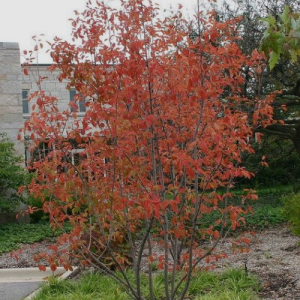
Serviceberry is a shrub or small tree that yields showy, white flowers. The plant’s clustered racemes are similar to that of a lilac. The flowers precede clusters of blueish-black berries.
SErviceberry trees are native to Colorado’s Western Slope. These incredible plants can grow to be anywhere from 20 to 25 feet in height and 15 to 20 feet wide.
European Mountain Ash (Sorbus aucuparia)
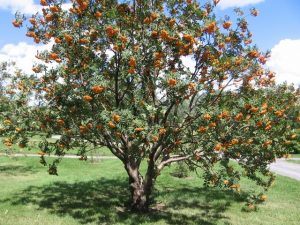
European mountain ash is an incredibly popular ornamental. Its compound leaves boast 11 to 15 alternating leaflets. The individual leaves are 1 inch in length and incredibly toothy around the edges. They’re accompanied by clusters of reddish-orange berries. The fruits are preceded by the tree’s dainty white blossoms. These flowers appear in rounded clusters. Each flower has five petals and hundreds of silky hairs.
Tulip Tree (Liriodendron)
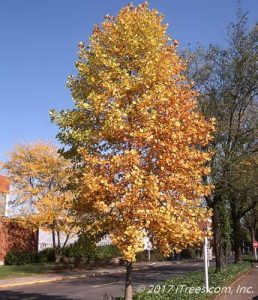
This late-blooming ornamental tree produces tulip-shaped leaves and flowers. The greenish-yellow blossoms present a welcome dose of color. The blossoms are 1.5 to 2 inches in diameter. They boast orange rings along their foundations. The flowers typically appear between late May and June.
It can take up to 15 years for this magnificent tree to start flowering. The unique blossoms are well worth the wait. Most trees go on to live extraordinary lives. The average lifespan of a tulip tree is between 200 and 250 years. These remarkable hardwoods are also quite tall. Most measure between 100 and 150 feet at maturity.
Mayday Tree (Prunus padus )
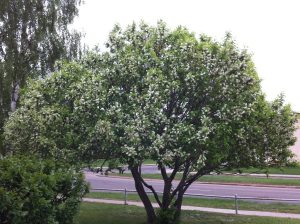
The mayday tree, or bird cherry, is a slow-growing ornamental tree that yields fragrant white flowers in spring and cherry-like fruits in summer. The blossoms grow from dropping racemes. The fragrant clusters are a huge draw for native pollinators and other insects. These trees tend to be low, bushy, and rounded. Most mature trees are no taller than 40 feet.
Ussurian Pear
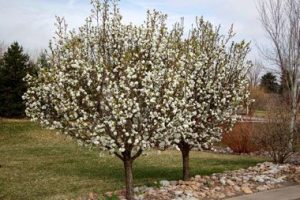
Ussurian pear is a self-pollinating ornamental tree that yields glossy leaves and white flowers. This particular tree can reach heights of 30 feet. Its canopy can expand as far as 50 feet. Though not poisonous, its fruits do not may enjoyable food. Most gardeners prefer them for their visual characteristics. Of course, they are readily consumed by birds and other small animals. The tree’s flowers are also attractive and fragrant. The pinkish-white blossoms boast overlapping petals and multiple stamens. They grow in clusters alongside the plant’s green foliage. The fruits are greenish-yellow and small.
Hawthorne (Crataegus)
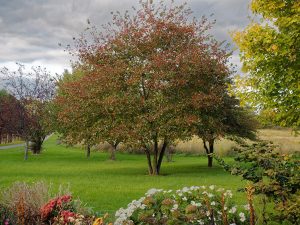
There are three varieties of hawthorn trees that are native to Colorado. These include the shiny-leaved hawthorn, the fleshy hawthorn, and the river hawthorn. These trees all yield white flowers and reddish-purple fruits. All of them also boast distinctively toothy leaves and sharp thorns.
The hawthorn tree is well-equipped to handle the high elevation of Colorado’s mountains. It prefers full sun but can tolerate a wide range of conditions. This hardy tree is even considered drought- and disease-resistant. Hawthorns support hundreds of different insects. Their pollen and nectar are essential to the survival of many native bees and other pollinating insects.
Russian Hawthorne (Crataegus ambigua) is a non-native ornamental tree that does particularly well in Colorado’s Front Range. It boasts yellow flowers, red berries, gnarled branches, and dense foliage.

